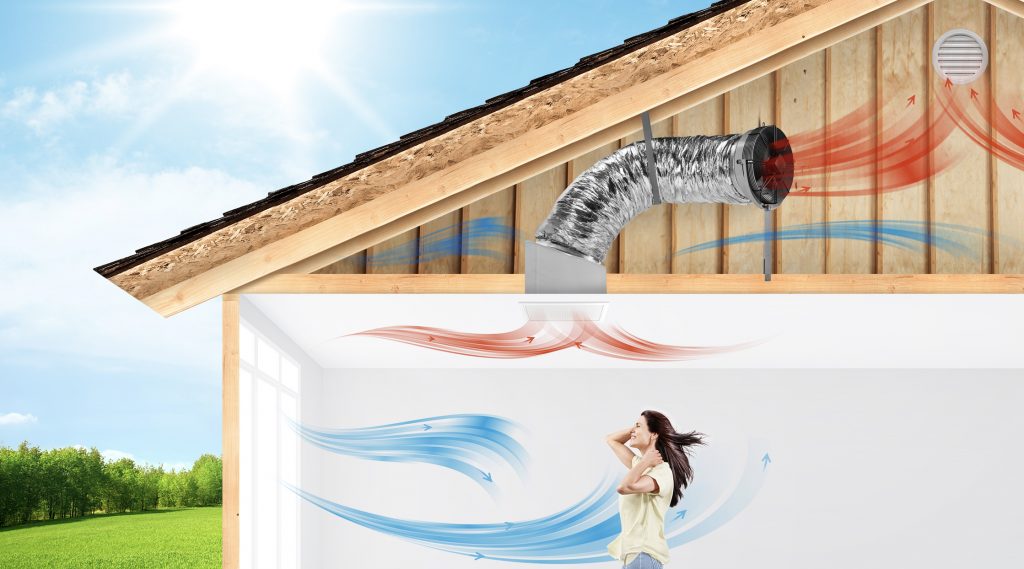- Idaho 83669
- 1 (208) 991-2785
- Office Hours Mon-Fri: 9:00am-4:30pm Sat-Sun:Closed

Whole House Fan Installation Services
Utilizing a whole house fan is a great way to reduce the amount of energy and money needed for cooling without sacrificing any level of comfort at home. These types of fans are capable of cooling the entire home during the hours when the temperatures indoors are greater than outdoors, such as evening and morning hours, by bringing in cooler air from the outside. It does this using only a fraction of the energy required by the air conditioning unit. Whole house fans come in a variety of sizes, determined by the amount of air they circulate, or whole house fan cfm. Having an understanding of this makes choosing the correct fan size for your home an easier process.
Understanding Whole House Fan CFM
Cubic Feet per Minute or CFM is the amount of cubic feet of air per minute the fan moves. The amount of power a fan has depends on this measurement. The higher the CFM is, the more powerful the fan is. The amount of power necessary depends largely on the amount of space being cooled. Larger spaces, of course, would require larger fans.
Determine how much air is being moved
Figuring out the amount of air exchanges that will occur within a certain time frame with open windows and a whole house fan is done by using the measurement of your home in square feet along with the CFM rating of the fan. As an example, let’s use a home that measures 2200 square feet, has an average floor-to-ceiling height measurement of 8 feet. Then lets measure the air exchanges per hour if you installed a whole house fan with CFM rating of 1600:
- Determine the home’s cubic measurement by multiplying the square footage by ceiling height:
2200 square foot home x 8 foot ceiling height = 17600 cubic feet - Divide the cubic feet measurement by the CFM rating assigned to the fan:17600 cubic feet ÷ 1600 = 11
This means that every eleven minutes, the air in the home is being changed or 5 times per hour. To facilitate faster air exchange would necessitate choosing a fan with a higher CFM. So as another example if you take the same home and install a whole house fan with a rating of 2800 CFM, you would get 9.5 air changes per hour. (17,600 / 2800).
You will find many different recommendations on air exchanges per hour and most do not agree. The department of energy used to recommend 3-6 air exchanges per hour and now recommends 15-23. Some fan manufacturers recommend a minimum of 4 air exchanges per hour while Quiet Cool recommends 15 – 22.
We will normally size a fan 12-20 air exchanges per hour if there is enough venting in the attic to accomodate this.
Some additional points for consideration in addition to CFM when choosing the correct venting fan include:
Power Requirements. The higher the CFM, the more wattage it required to operate the fan. However, there are numerous energy efficient models available in the marketplace that significantly cut down on power usage. Some fans even provide the option to operate on either a low or high speed each with varying CFM and hence power consumption levels. Having this option allows you to use even less energy on days that are cooler, but a fan is still needed.
Noise Level. Traditional fans have a higher noise level and can be quite loud in small spaces. There are several newer fans available on the marketing that are much quieter, getting down to 48 decibels (similar to an air conditioning unit at 100ft). This is an important factor when choosing a fan for your home.
Do You Need An Electrician For Installation?
The amount of work required to install a whole house fan varies from house to house, but can generally be retrofitted into an existing house. One major variable is the venting, if you plan on running the fan on high speed, (most people do) you need to make sure that there is enough exhaust venting in the attic for your highest fan setting. Fans are rated by cubic feet of air per minute or cfm. A good rule of thumb is to provide one square foot of net free venting area for every 750 cfm. Net free venting is the area after subtracting for louvers and screens.
Generally the vents are roof vents, louvered wall vents or eave vents. Some roof vents and some eave vents have their respective net free venting areas stamped right on them. Ridge vents, depending on type, are not as good for providing the bulk of vent area needed although they do help slightly.
A professional will help you with these variables. With installation, you should expect to pay $1000-$1900 for small fans and $2000-$3000 for large fans.
Contact Lemere Electric today to get an estimate for your project.
